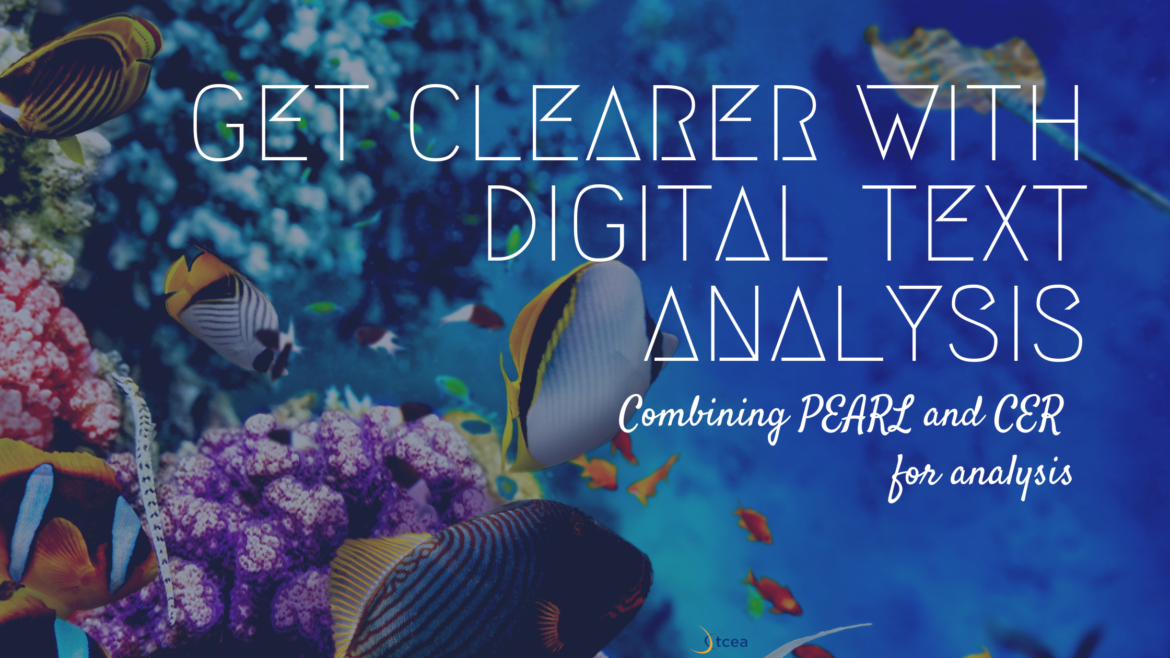While cruising Facebook groups earlier this month, I ran across this question. Having never heard of one of the acronyms, PEARL, I was curious to learn more about it. These days, acronyms are a dime a dozen. But this question resulted in some conversations among the Facebook group:
“Most of our middle and high schools (I’m a curriculum specialist) have all their students write PEARL paragraphs regularly. I’m trying to explain how writing in science is different than in ELA. I want them to use the CER format in science but the admins are telling me it will confuse kids. What are your thoughts?”
At the end, you’ll get access to a new, text analysis digital tool that combines PEARL and CER. Before I share that, let’s explore PEARL and CER first.
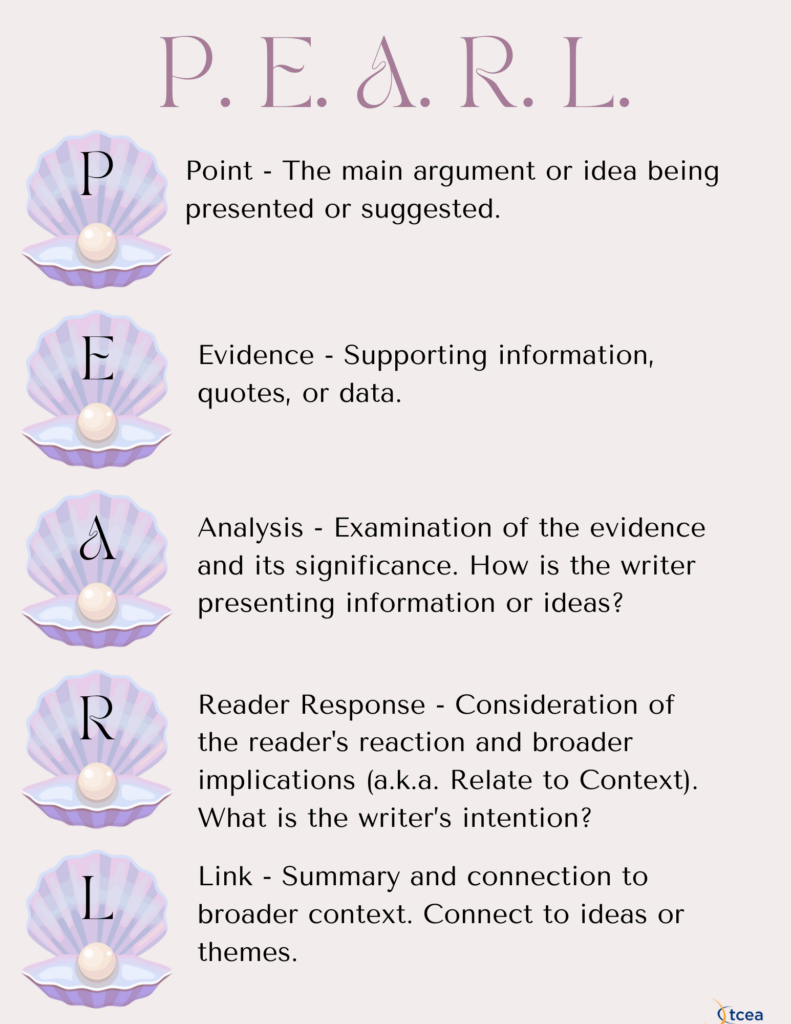
Engaging Students in Literary Analysis
Getting students (or anyone) to analyze what they read has become all the more important in the age of AI. Having some way to articulate what you think about a piece, construct an argument supported by evidence and reasoning can be tough. One approach is the PEARL acronym, although many rely on CER. Let’s review what each of these mean and then consider how they can be combined.
PEARL vs CER
The acronym represents five words or actions, including:
- Point
- Evidence
- Analysis
- Reader Response
- Link
As suggested, it may be relied upon in literary analysis. But it has startling similarities to Claim-Evidence-Reasoning (CER). Before we connect the two acronyms, let’s look at how you can use PEARL for both literary and scientific analysis.
PEARL Table
Here’s what PEARL looks like using fictional story, Charles Dicken’s A Christmas Carol. You will also see a nonfiction example featuring the Water Cycle. As you can see from the table, PEARL is versatile for both fiction and nonfiction, including science-related topics.
| Letter | Meaning | Explanation | Fiction Example (Literature) | Nonfiction Example (Science) |
|---|---|---|---|---|
| P | Point | The main argument or idea being presented | The writer uses the character of Scrooge to highlight the unfairness of society. | The water cycle is a crucial process that sustains life on Earth. |
| E | Evidence | Supporting information, quotes, or data | By referring to Scrooge as a “tightfisted hand at the grindstone”, the writer emphasizes… | According to NASA, about 71% of the Earth’s surface is covered in water, with 96.5% of that being in the oceans. |
| A | Analysis | Examination of the evidence and its significance | The metaphor “grindstone” connotes… which suggests… because… The writer uses the adjective “tightfisted” to… as this means that… | The term “hydrosphere” encompasses all of Earth’s water, including oceans, rivers, lakes, and even water vapor in the atmosphere. This vast amount of water is constantly moving through the water cycle, driven by solar energy. |
| R | Reader Response | Consideration of the reader’s reaction and broader implications | Clearly, the writer intends to criticize people in his society who are [specific trait] and selfish. This contributes to the overall impression that… | Readers might reflect on how human activities, such as pollution or deforestation, can impact the water cycle. This contributes to our understanding of environmental conservation and climate change. |
| L | Link | Summary and connection to broader context | Therefore, the writer uses the character of Scrooge to inform us of the unforgiving cruelty of life in Victorian London. | Therefore, understanding the water cycle is essential for comprehending Earth’s climate systems, weather patterns, and the distribution of water resources, which are vital for all life on our planet. |
You can combine all the results of the PEARL to get a final result that reads well.
Get CLEARER About the PEARL-CER JAM
Teaching students PEARL and CER can be valuable. As you might imagine, it’s easy to draw parallels between PEARL and CER. You can arrange the components of a scientific piece of writing to take advantage of both PEARL and CER. Follow these five steps:
- Start with a Claim/Point. State your main scientific argument.
- Provide Evidence. Present relevant data or observations.
- Offer Reasoning/Analysis. Explain how the evidence supports your claim and analyze its significance.
- Include Reader Response. Discuss implications or broader scientific context.
- End with a Link. Summarize and connect to larger scientific concepts or next points.
If you wanted to, you could even combine PEARL and CER into a new acronym to teach students. This would eliminate the confusion of two different acronyms. What would that acronym be?
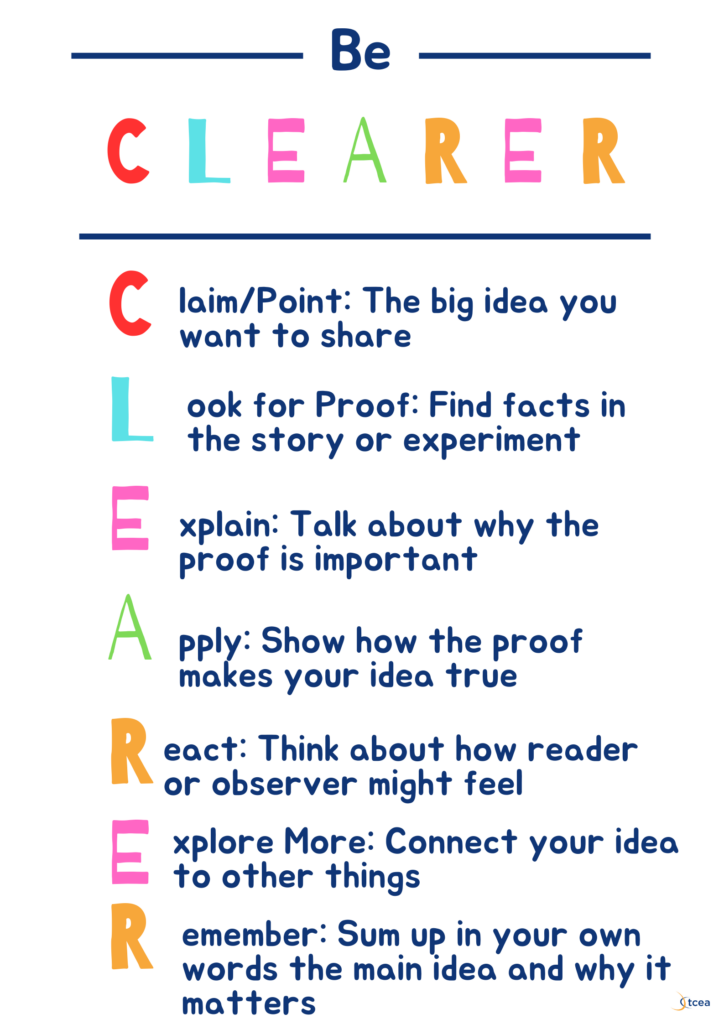
Introducing CLEARER
Well, it couldn’t get any clearer than this one:
- C – Claim/Point: The main argument or hypothesis
- L – Literature/Look for Proof: Evidence from text or scientific observations
- E – Examine: Analysis of the evidence
- A – Apply: How the evidence supports the claim
- R – Respond: Reader/audience implications
- E – Elaborate: Broader context and connections
- R – Recap: Summary and link to larger concepts
For fun, you can apply CLEARER to another bit of literature. I also have a simplified version of CLEARER below. Let’s take a look.
CLEARER Examples: Fiction and NonFiction
One of my favorite stories is the Three Little Pigs and you can’t get any simpler than the Water Cycle.
| CLEARER Component | Explanation | The Three Little Pigs Example | Water Cycle Example |
|---|---|---|---|
| C – Claim/Point | The main argument or hypothesis | The story of “The Three Little Pigs” shows us why it’s good to work hard and plan ahead. | The water cycle is a crucial process that sustains life on Earth. |
| L – Literature/ Data (Look for Proof) | Evidence from text or scientific observations | In the story, the pig who built his house with bricks was safe from the big bad wolf, while his brothers who used straw and sticks were not. | According to NASA, about 71% of the Earth’s surface is covered in water, with 96.5% of that being in the oceans. |
| E – Examine | Analysis of the evidence | In the story, only the pig who built a strong brick house was safe from the wolf. The brick house shows that doing things carefully is better. The wolf couldn’t blow it down because bricks are strong. | The term “hydrosphere” encompasses all of Earth’s water, including oceans, rivers, lakes, and even water vapor in the atmosphere. |
| A – Apply | How the evidence supports the claim | This shows that taking time to do things right pays off. | This vast amount of water is constantly moving through the water cycle, driven by solar energy, demonstrating the dynamic nature of the process. |
| R – Respond | Reader/audience implications | When we read this story, we might think about how important it is to plan ahead and do our best. | Readers might reflect on how human activities, such as pollution or deforestation, can impact the water cycle. |
| E – Elaborate | Broader context and connections | It makes us want to be more like the smart pig who used bricks. | This contributes to our understanding of environmental conservation and climate change. |
| R – Recap or Remember | Summary and link to larger concepts | So, “The Three Little Pigs” isn’t just a fun story – it’s also teaching us a lesson about being responsible and working hard to stay safe and successful. | Therefore, understanding the water cycle is essential for comprehending Earth’s climate systems, weather patterns, and the distribution of water resources, which are vital for all life on our planet. |
That’s pretty straightforward, no? Let’s look at a simpler version.
Simplifying a Little For Younger Students
The versatile, structured approach of CLEARER supports critical thinking and evidence-based reasoning. Working with my third grade students, I would revise CLEARER to show simpler explanations of each step.
- C – Claim/Point: The big idea you want to share
- L – Look for Proof: Finding facts in the story or experiment
- E – Explain: Talking about why the proof is important
- A – Apply: Showing how the proof makes your idea true
- R – React: Thinking about how the reader might feel
- E – Explore More: Connecting your idea to other things
- R – Recap: Summing up your main idea and why it matters
Now that you have an answer to your question about PEARL or CER, let’s take a look at digital tools for text analysis.
Performing Digital Text Analysis
Digital text analysis tools can be a game-changer in your classroom.Here are three ways students can tap into text analysis tools:
- Analyze literary texts
- Conduct research projects
- Create data-driven stories
Let’s look at each one of these through the CLEARER lens while using digital tools. A list of Text Analysis Tools K-12 students can use appears at the end of this blog entry.
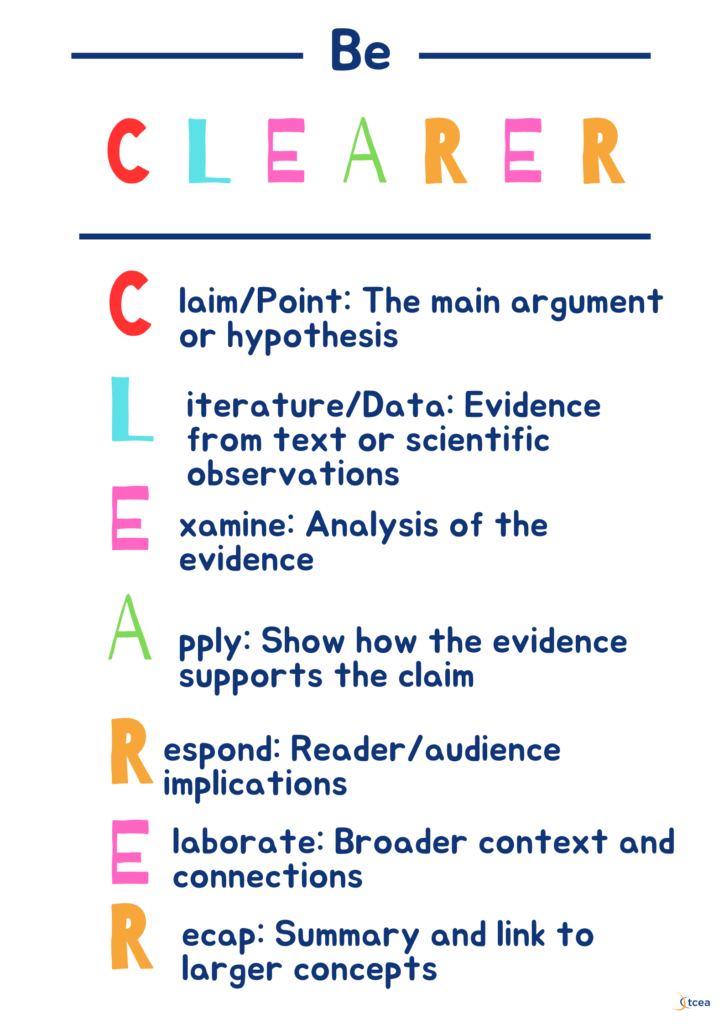
CLEARER Digital Text Analysis
Since the question at the start of this blog entry struggles with literary and scientific analysis, let’s analyze a story that relies on scientific thinking (and is one of my favorites).
Example #1: Analyzing Literary Texts
C – Claim/Point: State the main argument about the text based on initial observations.
L – Literature/Data: Use Voyant to generate word clouds and frequency data.
E – Examine: Analyze the visualizations and data patterns produced by the tools.
A – Apply: Connect the data to your claim, showing how it supports your argument.
R – Respond: Consider how these insights might change a reader’s understanding of the text.
E – Elaborate: Explore connections between the tool’s findings and broader literary themes.
R – Recap: Summarize how the digital analysis supports or challenges your initial claim.
Classroom Use Scenario: 11th-grade students analyze “Leiningen Versus the Ants” using Voyant. They start with a claim about the story’s themes, use the tool to examine word frequencies and patterns, and then apply these findings to support or refine their initial claim.
As you can see from the image below, Voyant Tools does a great job analyzing the text:
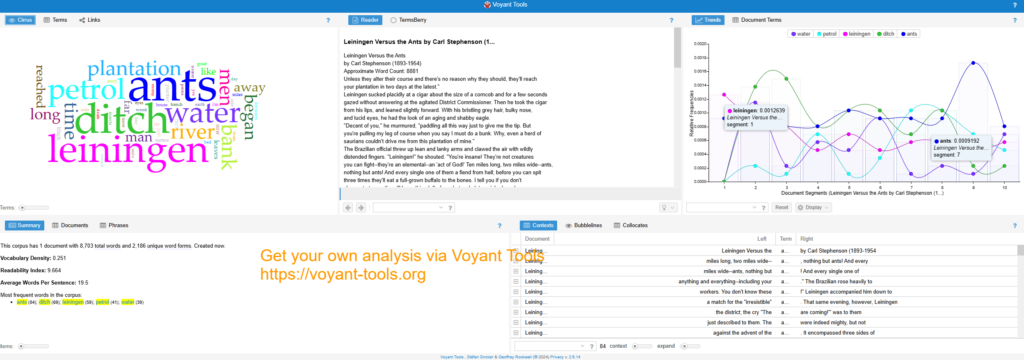
Here’s an explanation using CLEARER and Voyant Tools diagram about the story (Get a copy).
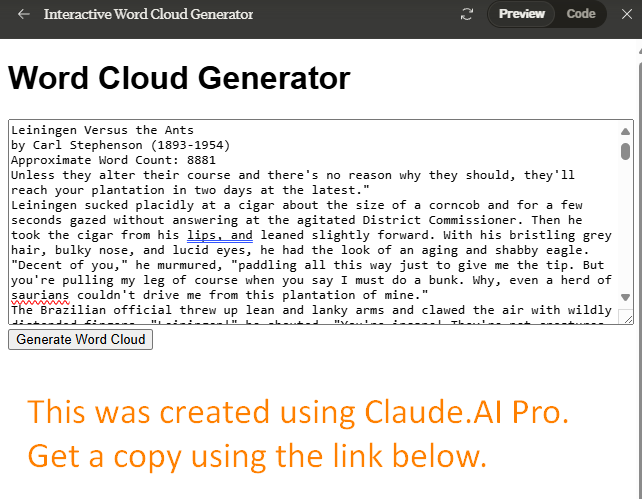
Get the Word Cloud Generator For You
For fun, I asked Claude.ai to create a Word Cloud Generator that works in your web browser. There are two versions, the simple one (get a copy), and the one that gives you a word cloud and a CLEARER analysis (get a copy). I dropped in the text of one of my favorite high school stories, Leiningen Versus the Ants, to get the following result:
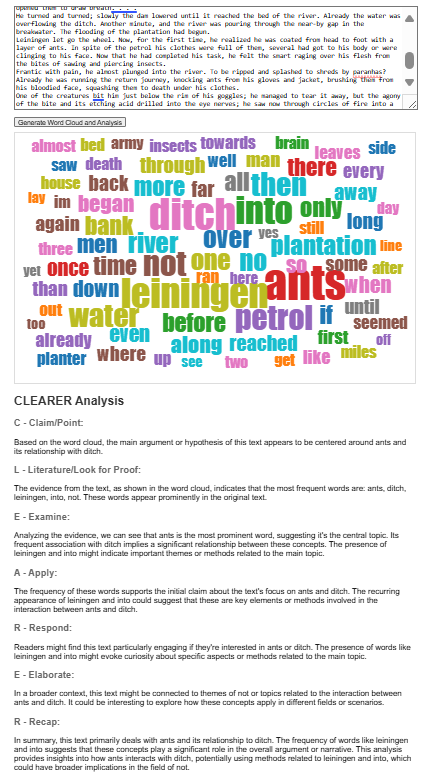
Give it a spin! As you might imagine, the word cloud might be more useful than the AI generated analysis. Maybe have your students do that analysis part.
Get CLEARER with Digital Text Analysis
By empowering students with text analysis tools, you can help them develop essential skills in critical thinking, research, and data analysis.
Want some more tools in addition to the TCEA Word Cloud Generator with CLEARER Analysis and Voyant Tools?
Here are some text analysis tools that students can use in the classroom, alphabetized by tool:
| Tool | Description | Price |
|---|---|---|
| ATLAS.ti | A tool designed to help analyze all types of unstructured data (text, multimedia, geospatial). | Custom pricing for education institutions |
| Dedoose | A qualitative data analysis software that facilitates rigorous mixed methods research. | $11.95/month (basic plan) |
| f4analyse | A low/no-code tool for data analysis that allows users to use analytic methods without coding. | Custom pricing for education institutions |
| HathiTrust | A digital library with text analysis tools. | Free (for partner institutions) |
| InfraNodus | A visual text analyzer platform with gap insight analysis. | Free trial, then €9/month (basic plan) |
| Lumos Learning | A free text complexity analysis tool that evaluates reading passages using various metrics. | Free |
| MAXQDA | A qualitative, quantitative, and mixed methods research tool that’s particularly well-suited to processing interviews. | $49 (one-time purchase, student license) |
| MonkeyLearn | A no-code machine learning platform for text analysis. | Free trial, then $299/month (basic plan) |
| Relative Insight | A customer feedback analysis solution that detects linguistic and attitudinal differences. | Custom pricing for education institutions |
| SimpleX | An AI-powered smart console for text analysis. | $49 (one-time purchase) |
| Tableau | A data visualization tool that can be used for text analysis. | Free trial, then $35/month (basic plan) |
| Thematic | A customer feedback analysis solution that can be used in education settings. | Custom pricing for education institutions |
| Voyant | A web-based text reading and analysis environment. | Free |
Did you get a copy of all the posters in this blog entry? Use this handy template link to get the copy of all posters via Canva (which is free for educators).

